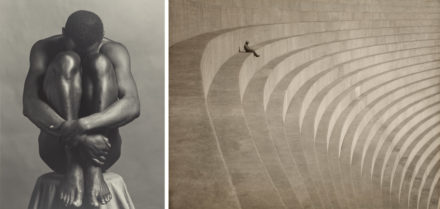
Mural, 1943, Jackson Pollock (American, 1912–1956). Oil on canvas, 8’ ¼” x 19’ 10”. University of Iowa Museum of Art, Gift of Peggy Guggenheim, 1959.6 Reproduced with permission from The University of Iowa
It’s official—abstract expressionist painter Jackson Pollock’s seminal work Mural (1943) will be undergoing technical study and conservation at the Getty Center as part of a new collaboration between the Getty and the University of Iowa Museum of Art.
The painting will travel to the Getty Center this summer, where it will undergo a two-year technical study and conservation treatment by research scientists at the Getty Conservation Institute and conservators at the J. Paul Getty Museum, after which it will be exhibited at the Museum for three months.
Pollock (1912–1956) is considered one of the most influential painters in American history. Mural is widely recognized as a watershed for the artist, and is credited with inspiring the emergent Abstract Expressionists of the mid-20th century. Mural is said to have been Pollock’s first commission by legendary art collector Peggy Guggenheim, and has been in the University of Iowa’s collection since it was gifted by Guggenheim in 1951.
Yvonne Szafran, head of paintings conservation at the Getty Museum, told me last week that “All paintings require some conservation treatment over time, and Mural is no exception. Visually, its surface looks dull, so it will need to be cleaned. And although though the lining is structurally sound, some structural work also will be needed. At the very minimum, a new stretcher will be required to provide more adequate support for the painting, which is very heavy.”
Prior to the conservation, the Getty team will be collaborating on an investigation into the materials and techniques of the painting, and together will develop a comprehensive treatment approach.
It’s the technical study which will provide the opportunity to investigate Pollock’s technique, the types of paints he used, and potentially even how Pollock applied them. It’s this kind of revelation that could lead to a whole new insight to the artist’s process.
But why the Getty? After all, Pollock’s work is modern art, not something represented in the Getty Museum’s collection, aside from photography and outdoor sculpture.
“The GCI has been researching the many and varied conservation challenges presented by modern and contemporary art for a number of years,” shares Tom Learner, head of the GCI’s Modern and Contemporary Art Research initiative. “In particular, we have undertaken detailed studies of how paints from the 20th century differ from those used by the Old Masters, in terms of how they age or how best to clean them. It’s really important that we work side-by-side with conservators at this point to ensure the impact of this research is being maximized. Conserving Mural fits in very well with this existing research program.”
As well, the Getty Museum’s Paintings Conservation Department regularly undertakes the conservation of works of art from institutions around the world as part of the Getty’s overall philanthropic mission. These projects are accomplished at little or no cost to the institution in exchange for the opportunity to show the work in the Museum’s galleries following conservation.
As the project moves forward, look for updates here on the Iris. The most exciting part is yet to come.




Comments on this post are now closed.
Trackbacks/Pingbacks